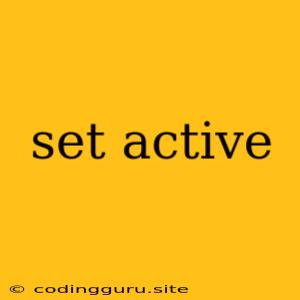Setting the Stage: Understanding the Power of "Set Active"
In the realm of programming, especially within web development, the term "set active" often pops up. But what exactly does it mean, and why is it so vital? Let's break down this seemingly simple phrase and reveal its powerful role in shaping user experiences.
Imagine browsing an online store. You navigate through various product categories, each with a list of items. You might click on "Shirts", then "T-shirts", and finally land on a specific "Cotton T-shirt" product page. As you move through these categories, something intuitive happens: the corresponding navigation element changes. The "Shirts" category becomes active, visually indicating your current location within the website's structure. This is the magic of "set active".
So, what is "set active"?
In a nutshell, "set active" is a common practice in web development that signifies the current state of an element or component. This could be a navigation link, a tab, a button, or even a menu item. When an element is set active, it receives a visual cue, often in the form of a change in color, background, border, or even a small animation. This simple change provides users with clear visual feedback, guiding them through the website's interface.
Why is "set active" important?
The importance of "set active" lies in its ability to enhance user experience and website navigation.
- Clear Visual Hierarchy: It creates a clear visual hierarchy, helping users understand their current location and navigate effortlessly.
- Improved User Engagement: By highlighting the active element, you subtly direct user attention and encourage interaction.
- Enhanced Accessibility: For users with visual impairments or cognitive disabilities, "set active" can be crucial for understanding the website structure and navigating efficiently.
How to Implement "Set Active"
The implementation of "set active" varies depending on the technology used. Let's explore a few popular scenarios:
1. Using HTML and CSS:
The most common method involves using CSS classes to manage the active state. For example:
.navigation li.active a {
color: #007bff; /* Blue color */
background-color: #e9ecef; /* Light grey background */
}
In this example, the active class is added to the li element representing the currently selected category, and the corresponding CSS styles modify the link's appearance to clearly indicate its active state.
2. Using JavaScript:
JavaScript allows for more dynamic and interactive implementations of "set active". Consider this example:
const navigationLinks = document.querySelectorAll('.navigation a');
navigationLinks.forEach(link => {
link.addEventListener('click', () => {
navigationLinks.forEach(l => l.classList.remove('active'));
link.classList.add('active');
});
});
This code snippet iterates through all navigation links, removes the active class from all links, and then adds it to the specific link that was clicked. This ensures that only the currently active link is highlighted, providing a dynamic and user-friendly navigation experience.
3. Using Frameworks:
Popular front-end frameworks like React, Vue, and Angular offer built-in methods and components for managing active states. These frameworks often streamline the process by handling event listeners, class manipulation, and rendering updates efficiently.
Beyond Navigation: Exploring the Applications of "Set Active"
While "set active" is commonly used in navigation, its applications extend far beyond. Consider these examples:
- Form Validation: Highlighting input fields with errors through "set active" helps guide users to correct their input.
- Interactive Components: In complex dashboards and interfaces, "set active" can be used to visually emphasize the element currently being interacted with.
- Dynamic Content: You can dynamically switch between different views or content sections using "set active" to highlight the currently displayed section.
Remember: The primary goal of "set active" is to enhance usability by providing clear visual cues that guide users through your website or application.
Considerations for Effective Implementation
To ensure your "set active" implementations are effective, keep these points in mind:
- Consistency: Use consistent visual styles for active elements across your website or application. This creates a predictable user experience.
- Clarity: The visual changes should be clear and noticeable, without being overwhelming.
- Accessibility: Consider users with visual impairments by ensuring sufficient color contrast between active and inactive states.
- Contextual Relevance: The "set active" state should be relevant to the user's current context and actions.
Conclusion
"Set active" is a simple yet powerful concept that can dramatically improve the usability and engagement of your web projects. By understanding its role and utilizing best practices for implementation, you can build more intuitive and engaging experiences for your users. Remember, a well-designed "set active" implementation can be the difference between a confusing website and an intuitive, user-friendly experience that keeps people coming back for more.
